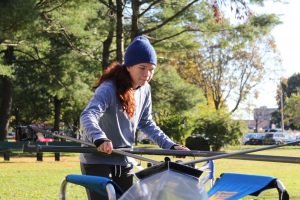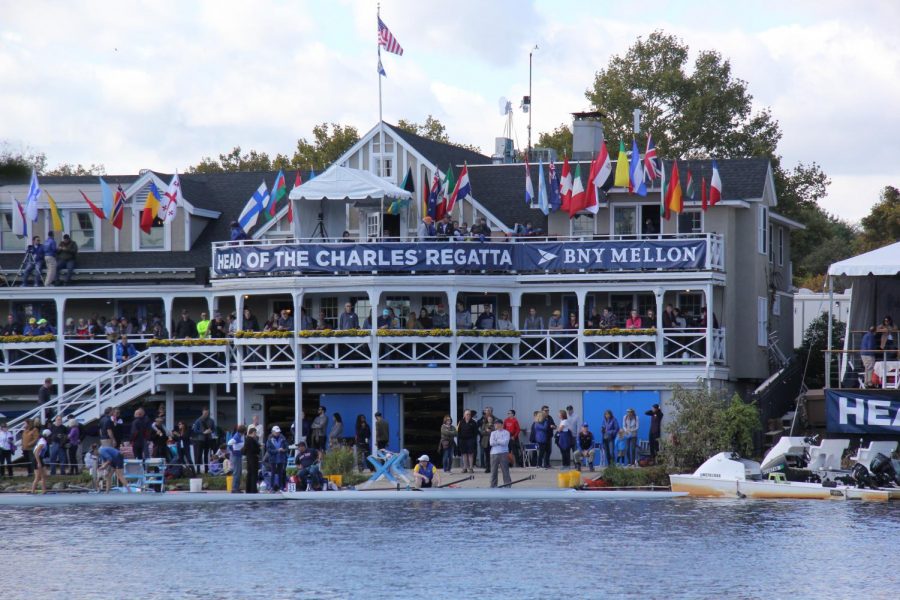Mac rowers race on biggest stage
The BNY Mellon Boathouse was crowded with rowers, coaches and fans during the Head of the Charles Regatta on the Charles River in Boston on Oct. 20. For two days, thousands of elite rowers sprinted by the boathouse with the finish line in sight. Photo by Sarah Slaten.
November 12, 2018
The Head of the Charles Regatta, which was held on the Charles River in Boston on Oct. 20-21, is one of the most revered rowing events in the United States. More than 10,000 rowers compete in the regatta every year in almost 2,000 boats. The event attracts hundreds of thousands of people to Boston to compete in and witness the competition. In other words, it’s a pretty big deal.
Among the thousands of rowers throughout the world who were invited to compete in the regatta were McCallum senior Raiya Myren and junior Sarah Slaten.
“It’s the biggest two day regatta in the whole world, and it was kind of crazy because people in Boston actually come to watch it,” rower Sarah Slaten said. “They didn’t have anything to do with it, but everywhere we went they asked why we we’re here, and we said ‘we’re here for the Head of the Charles,’ and they’re like ‘Oh My God.’”
The Head of the Charles attracts people not only from across the United States, but throughout the entire world.
“There were people from London and Canada,” Slaten said. “There might have been some Australian people, so that is pretty cool.”
Both Myren and Slaten were invited based on a random drawing of rowers who applied (only the top 25 percent of rowers from the previous year’s race are automatically invited). Myren was invited to compete in the Women’s Youth Singles division while Slaten raced with three other teammates in the Women’s Youth Fours division.

“[My coach] called me after practice and told me [I had been invited], and I started screaming,” Slaten said. “And then I hung up and I ran around the house and called my mom and my dad and told them. It was great.”
Beyond the challenges that come with racing on a course as difficult as the Head of the Charles and competing against some of the best rowers in not only the United States, but in the entire world, each of the rowers had other challenges to overcome. One of those challenges was the persistent rain and flooding in Austin in the days leading up to the race.
“Because of the weather we hadn’t been able to practice on the water recently,” Myren said.
Maybe an even greater challenge for Myren, however, was the fact that this was going to be the first time that she had ever competed in a singles competition before, meaning that the first time she would ever race by herself, would be on the biggest stage in the continent.
“It was kind of scary because I was rowing a single person boat which I had never done before and I was doing it at the biggest regatta in North America, which is known to be a really challenging course,” Myren said.
Myren was understandably intimidated by the course before she competed, but she finished the race feeling good about her performance, which placed her 27th out of 32 rowers.
“I thought it was going to be a lot worse than it ended up being,” Myren said. “It’s played up as this impossible course with huge turns. You have to make a 90 degree turn at one point, but it wasn’t that bad and everyone has the same struggles so I didn’t feel as singled out as thought I was going to. It turned out to be not as overwhelming as I thought it was going to be. And I achieved my goal of not hitting anything or anyone of flipping or breaking equipment and I didn’t get last. And when you are competing against a bunch of national champions that’s all you can hope for. I think I did pretty well.”
Another challenge Slaten and her team had to face was that they had never competed with the four of them all together before.
“My boat hadn’t raced against anyone so we had absolutely no idea how we were going to do,” Slaten said.
Despite their inexperience in racing together, the team did better than Slaten had expected, getting 17th out of the 42 teams.
“I didn’t think we were going to do very well, personally, but we got top half so it was better than I expected,” Slaten said.
Although the team wasn’t quite able to finish within the top 25 percent of teams, which would have given them automatic qualification into the 2019 Head of the Charles Regatta, finishing in the top 50 percent will improve their odds of getting into next year’s race.
Both Slaten and Myren had a good experience in their first Head of the Charles.
“It was fun and it was a great way to experience Boston with my close friends, but in an atmosphere that was directed to rowers,” Myren said. “The whole city was getting pumped about it which doesn’t happen [in Austin] so it was interesting.”
Slaten and Myren’s next race will take place on Nov 3rd or 4 at the Head of the Hooch Regatta in Chattanooga, Tenn. The Head of the Hooch is the second biggest regatta in North America behind only the Head of the Charles.

Myren hopes she can improve on her result at the Head of the Charles in the Head of the Hooch.
“I’m rowing a single, so hopefully I do better in [the Hooch] and the competition won’t be as fierce,” Myren said.
Myren also said that she wants to continue rowing in college, listing MIT, Smith, Rice, and Georgia Tech as places where she may continue her rowing career. Myren loves rowing and wants to continue competing in part because she feels it helps with her mental health.
“[Rowing] helps me destress and get out the obsessive compulsiveness,” Myren said.
Slaten has very high hopes in her team for their next race at the Head of the Hooch.
“I’ve checked, and the people who beat us in Charles are not at Head of the Hooch and people that we beat are there,” Slaten said. “So I expect to win.”




